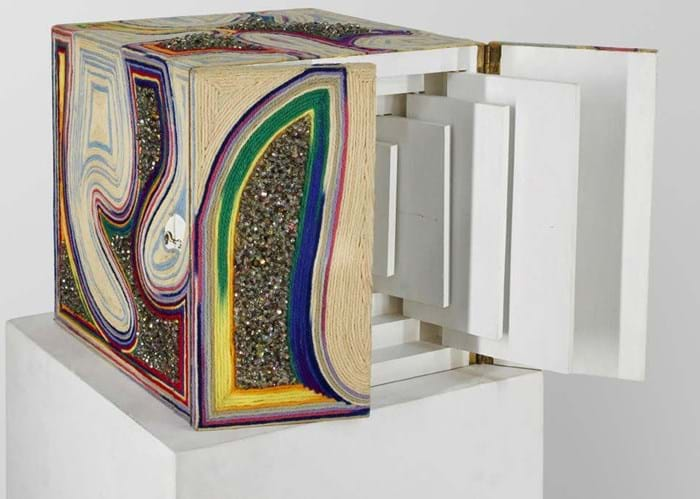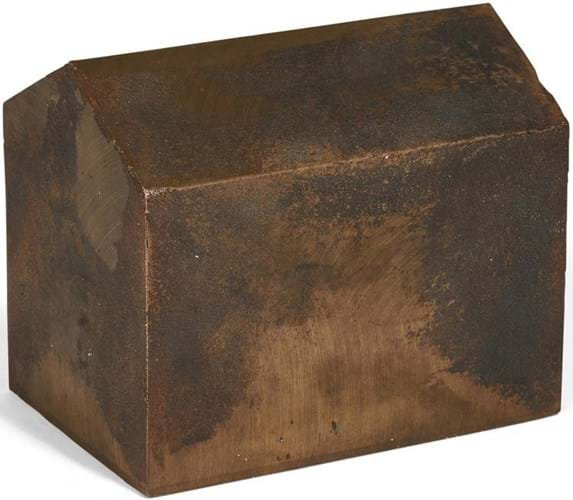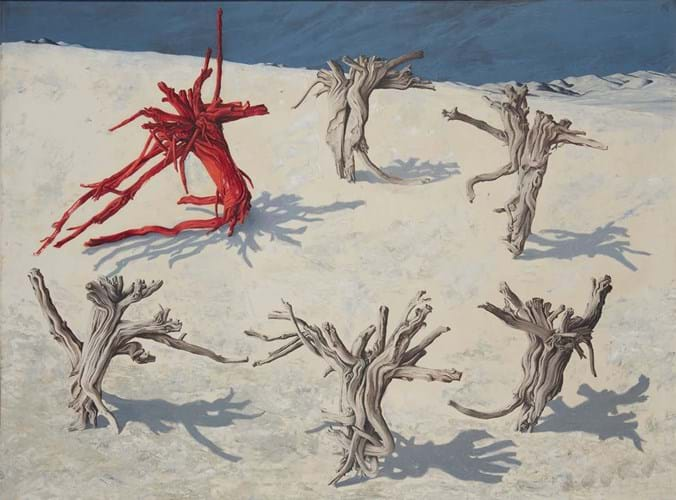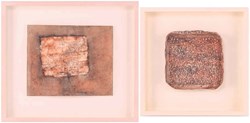
Chair Transformation #22 by Lucas Samaras, sold for £60,000 as part of the Saatchi & Saatchi collection at Roseberys.
Back in the late 1980s and 1990s, the market for Post-war and Contemporary art in the UK began to take giant strides forward.
With changes in taste coinciding with financial deregulation and increasing globalisation, this sector of the art market experienced its own Big Bang of sorts as the primary market expanded rapidly and then, somewhat later, this fed through to the secondary market and auction totals in this category began to increase.
It quickly became seen as the sector offering the highest returns on investment and the place to plant speculative money. Over time it would come to outrank Impressionist and Modern art as the highest grossing overall category.
Despite the major downturn of 2008-9, these developments have largely been sustained. Nevertheless, the high growth of the Post-war and Contemporary auction market during this period has, in large part, been the preserve of the major London rooms.
It is only really over recent years that some of the market has begun filter outwards and downwards to any great extent.
A few signs of this steady trickledown effect have been witnessed so far in 2023, with some significant results recorded for decent middle market material in particular.
While gaining consignments of good material has always been problematic for smaller auction houses, a couple of notable individual lots and collections have appeared at sales beyond Mayfair over the last few months.
These have included an increasing number of works by international artists creating waves in UK salerooms.
Saatchi source
A recent case came at Roseberys (25% buyer’s premium) when the south London saleroom attracted international bidding and posted a £240,000 hammer price for a Bindu picture by Indian artist Syed Haider Raza (1922-2016).
Reported in News Digest, ATG No 2592, the price fetched was the highest at a UK auction for an example from this series.
This followed a sale earlier in the year when the firm offered a group of over 40 works owned by the advertising company Saatchi & Saatchi.
Charles Saatchi was famously one of the buyers who helped generate the original expansion of the sector in the first place, amassing a large and varied collection that had both its admirers and critics.
The fact that now, three decades on, works acquired for the advertising firm he established with his brother Maurice (now Lord Saatchi) should now be offered outside of Bond Street and St James’s seemed symbolic of the widening auction market.
Many of the pictures and sculptures at Roseberys had been acquired in the 1980s and had featured in Alistair Hicks’ 1989 book New British Art in the Saatchi Collection.
With the brothers departing the company in 1994-5, most of these works had not been seen publicly since.
Although eight lots were withdrawn, the remaining 39 lots at the auction on March 14 performed well, with 31 selling for a hammer total of just over £260,000.
Wooden wonders
Among the works by overseas artists posting significant sums, two wooden constructions by Lucas Samaras (b.1936) led the proceedings.
Born in Kastoria in Greece,
Samaras emigrated to the US at the age of 11 and became part of a group of experimental artists whose varied output ranged from minimalism and conceptual sculpture to neo-expressionism and body art.
He also became known for incorporating photographic elements to his work after acquiring a Polaroid 360 camera in 1969.
With works now in major collections such as New York’s Met Museum and London’s Tate Modern, his art normally appears at Sotheby’s and Christie’s when it comes to auction.
The two examples from the Saatchi & Saatchi collection at Roseberys were from the mid-late ‘60s – an appealing date for buyers in this market.
First up was Box #51, a sculptural work from 1966 comprising a painted boxed with multiple doors and decorated with coloured yarns, plastic jewels and coloured acetate. The inside of the box contained a glass bottle, an electric light bulb and a rotating magnetic stirrer.
A note in the catalogue stated: ‘The luxurious – almost fetishistic – bejewelled exterior contrasts with its hidden interior, guarded by multiple doors, reflecting the contrast between the exterior and interior self that has preoccupied the artist throughout his career’.
Measuring 14in (36cm) high, it was an early example of Samaras’ boxes – he produced a numbered series of 135 works on this theme in total from 1960 onward.
This one had originally been purchased from New York’s Pace Gallery by the US collectors Burton and Emily Hall Tremaine who also owned works by the likes of Jasper Johns and Andy Warhol. It was acquired by Saatchi & Saatchi after selling as part of the auction of the Tremaine collection at Christie’s New York in 1988 where it fetched $55,000 (£30,360).
Estimated at £100,000-150,000 at Roseberys, it drew a battle between two international bidders on the phone and was eventually knocked down at £140,000 to one of them, a collector.
While the auction record for Samaras stands at a hefty $530,000 (£381,585) for Box #119 from 1987 that sold at Christie’s New York in 2021, this was the highest price for the artist at a UK auction.
The following lot was titled Chair Transformation #22 and dated from 1969-70. Again it was part of a series, in this case 25 works based on the theme of chairs metamorphosising into other forms, and it had also originally been purchased from the Pace Gallery.
This one was made of wood and mirror glass and measured 3ft 4in (1.03m) high. It had been included in an early retrospective of the artist’s work at the Whitney Museum of American Art in 1972-73.
Offered with a lesser estimate of £12,000-18,000, it drew greater competition as multiple bidders participated on the phone and online. It was eventually knocked down at £60,000 to the same international private collector, fetching the second-highest price for the artist at auction in the UK, only behind the above-mentioned lot, and the second highest for one of Samaras’s chairs – ChairTransformation #20B from 1996 had made $180,000 (£115,200) at Sotheby’s New York in 2015.
Shapiro sculpture
Elsewhere at the Saatchi & Saatchi sale, another sculptural work bringing demand was Untitled (House) by American artist Joel Shapiro (b.1941). A bronze and lead minimalist structure measuring 5in (13cm) high, it was part of an edition of three from 1974.
While the artist can make sixfigure sums at auction for his larger monumental figures, this small example of the Shapiro’s simplified geometric constructions was estimated at £7000-9000 and sold at £22,000 – a sum that appears to be the highest at auction for this edition.
Back to Brits
As well as the Saatchi & Saatchi collection, Roseberys offered a mixed-owner sale of 20th century art on the same day which had more of a British focus. Among the notable results was a major record for Marion Adnams (1898-1995). The artist studied at the Derby School of Art during the 1930s and had her first solo show at Jack Bilbo’s celebrated Modern Art Gallery in London in 1944.
While she produced a range of work during her career, she is best remembered for her distinctive Surrealist paintings.
A retrospective at Derby Art Gallery in 2017-18 helped her regain some recognition as did the appearance of some of her works at Dulwich Picture Gallery’s British Surrealism show in 2020 (where they hung alongside those of her contemporaries Ithell Colquhoun and Leonora Carrington).
Very few Adnams pictures have emerged on the market over the last 20 years partly due to the fact that she stopped painting in the late 1960s due to her deteriorating eyesight meaning her intricate works are quite rare.
The example at Roseberys was the largest and most important of her works to ever come to auction.
The 2ft 6in x 3ft 4in (76cm x 1.02cm) signed oil on board from 1963 titled La Ronde depicted anthropomorphised trees, one of her most prominent subjects which she returned to throughout her career. Showing leafless trees twisting like ancient figures in an expansive landscape, it had similar motifs to some of her best known works now in Derby Museum.
With the heightened interest in British female artists on the current market, particularly early Surrealists, the auction house was confident this picture would do well and gave it an estimate of £6000-8000, well over the artist’s previous auction record of £3300.
After generating an intense competition, it was eventually knocked down at £22,000 to a UK private collector.
It will be interesting to see if this new benchmark yields further works to the market, perhaps more material to indicate the ‘trickle down’ effect.

















